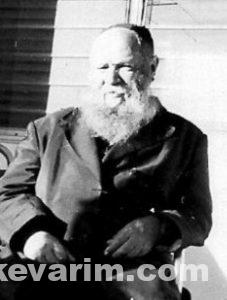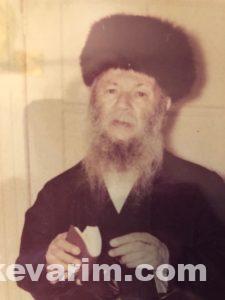Rebbe Yitzchok Tzvi Taub
יצחק צבי ב"ר ישראל
Modzitzer Rebbe of the BronxDate of Death:
Fri. October 30, 1964 -
Cheshvan 24 5725
Anyone with biographical information is asked to please send it in.
See CONTACT page for details. Thank you.
Directions to Kever: Washington Floral Park Cemetery, also known as Deans Cemetery located in Monmouth Junction, New Jersey maintains computerized records and will provide a detailed location map upon request. Location: Corner North First and South First Street, across from the Dombrova Section)
Biographical Notes:

Photo Caption: Modzitzer Rebbe of the Bronx, Credit: Yehudis Schonbrun

Photo Caption: Modzitzer Rebbe of the Bronx, Credit: MCA

Photo Caption: The Rebbe’s father, Credit: N/N
Bio Information:
The Rebbe’s father, Rebbe Yisroel a grandson of Rebbe Yechezkel of Kuzmir (d. 1846) was the founding father of the Modzitzer chasidic court.
Rebbe Yisrael Taub, the second son of Rebbe Shmuel Eliyahu of Zvolin, was born in 1849. In 1888, he succeeded his father in Zvolin and in 1891 relocated to Modrzyc (Demblin), Poland, where he soon became known as the Modzitzer Rebbe. The Rebbe famous for his composition abilities is believed to have composed over 200 melodies. A story is told that the Rebbe, who suffered greatly from diabetes traveled to Berlin in 1913 for a critical life-saving operation. Observing the beautiful architectural buildings in Berlin from his hospital window, the Rebbe was visibly saddened. The view, by comparison, reminded him of the desolation and destruction of Yerusalyim. During the operation, he composed his epic masterpiece based on the words of Ezkero (recited on Yom Kippur). The niggun (melody) comprised of 36 sections each contrasting in nature and takes over a half-hour to sing, is still popular with Modzitzer chassidim today. His teachings on Breishis, Shemos and Vayikra have been collected and published under the title Divrei Yisrael. Unfortunately, the writings on Bamidbar and Devarim were lost.
Source: Needed
« Previous: Rebbe Elimelech ReinmanNext: Rabbi Yitzchok Fisholes »



The Rebbe also had a shule in Miami Beach for many years.
Nachum,
Interesting note, his granddaughter does not mention it in her blog (see link above), are you sure it is this Mudzitzer Rebbe?
I have letters from him, written his Miami Beach stationary.
Nachum,
I found letters written on his Miami Beach stationary, but it does not mention that he actually had a Shul there.
Here are some of his letters from the Bloch Collection:
http://www.archive.org/stream/chaimbloch00reel03#page/n475/mode/1up
does anyone know where the divrei yisroel is buried?
Warsaw